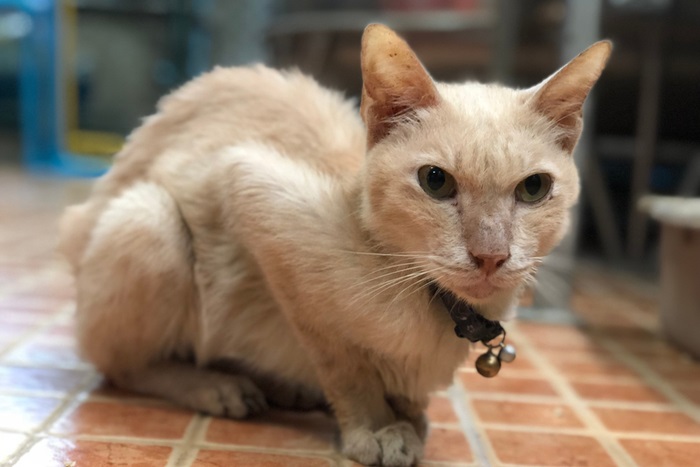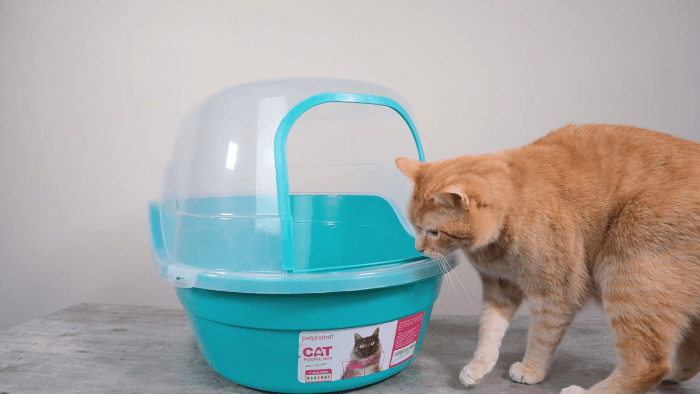
This article aims to explain the details of Giardiasis, a parasitic disease that can affect many mammalian species, including cats, dogs and humans. The aim of this article is to provide a simple, clear explanation about Giardiasis for cat owners.
Quick Overview: Giardiasis In Cats






What Is Giardiasis?
Giardiasis (also known as “Beaver Fever”) is a condition that develops in mammals following infection with the intestine-based microscopic protozoan parasite Giardia lamblia (also known as Giardia duodenalis and G.intestinalis). Humans may rarely have the potential to be infected with these intestinal parasites, which adds an extra note of concern to carers when pets are diagnosed.
How Widespread Is Giardiasis?
The parasite has a global distribution including the United States. The parasite can affect all mammals, and has been found to be present in 5 – 15% of cats and dogs, although often these infections are asymptomatic, and their carers are not aware of the issue.
What Is the Life Cycle of the Giardia Parasite?
Giardia lamblia (G.lamblia) is a protozoon, single-celled parasite: this means that it is so tiny that it can only be seen under the microscope. The organisms affecting different species of mammals were used to be classified as different species of Giardia, but because they appear identical, they are now thought to be variants of the same single species.
Recent molecular technology has identified eight different types of “assemblages”, labelled from A to H, that are used to identify the variants.
Cats are most commonly infected with type F, dogs are prone to infection with C and D, while humans are nearly always infected with types A and B. Cats and dogs are, on rare occasions, also diagnosed with types A and B, which is why there is sometimes concern about the risk of humans picking up the condition from pets.
The life cycle of the parasite is straightforward. There are two life stages: cysts and trophozoites.
- Giardia cysts are tough, resilient structures that allow the organism to survive for many months in the environment. Typically, each cyst contains two of the other form of Giardia, trophozoites. If a cyst is ingested, it bursts in the intestines, releasing the trophozoites.
- Trophozoites are the more active version of the organism, interacting with the host in the cat’s intestines, and causing signs of disease. They are not resilient and will not survive for long in the environment in this form, but if trophozoites are released in the faeces into the environment, they tend to form cysts, which are long-lasting.
How Do Cats Get Infected?

Cats become infected with giardia parasites when they ingest cysts or trophozoites from the feces of an infected animal.
Cats, humans, and other species can become infected with Giardia by ingestion of cysts or trophozoites from the feces of infected animals, either via direct contact with other cats or their feces (e.g. via the hair coat when grooming each other), or via contaminated food, drinking water or even soil. Trophozoites do not remain active in this form for long in the environment, so cysts are the main method of transmission.
How Do Infected Cats Pass On Giardia Infection?
Infected cats pass Giardia trophozoites or cysts in their feces from 5 to 15 days after they pick up infection. The organism is passed on to other cats either by direct contact, or by indirect contact via food, water or objects in the environment such as a litter box.
How Does Giardia Cause Disease in Cats?
It’s the trophozoites that cause disease: if cysts are ingested, they burst, releasing trophozoites, or if trophozoites are ingested, they cause disease directly themselves.
Trophozoites multiply, moving around inside the intestinal contents as well as attaching to the mucous membranes of the intestinal wall. They remain inside the intestines: they are not absorbed into the animal or the bloodstream.
They cause diarrhea by disrupting the normal function of the intestines, causing hypersecretion (increased secretion of fluids) into the intestines, which increases the fluid component of the feces, and also by causing malabsorption (preventing the normal absorption of intestinal contents into the bloodstream), which also increases the fluid component of the feces.
Not all animals show signs of illness: Giardia infection is often asymptomatic. Diarrhea is seen more commonly in young animals or in individuals that are immunocompromised (e.g. infections with viruses like FIV, cats on chemotherapy, elderly cats, or those suffering from other illnesses).
Symptoms of Giardia in Cats

Even if you have only one cat, it’s important to provide enough litter boxes so that your cat (or cats!) have options to choose from and a relatively clean place to go.
Some cats show no clinical signs of infection with Giardiasis. Other cats suffer from small intestine-based diarrhea, which can vary from slightly loose feces right through to a water-like consistency.
The feces may be mucus-streaked and particularly foul-smelling. Flatulence, abdominal pain, and vomiting may be noted. Rarely, blood may be seen in the feces, and a high temperature may be recorded. Abdominal distension, dullness, and weight loss may be seen in severe or chronic cases.
How Common Is Giardiasis in Cats?
Due to the presence of asymptomatic carriers, prevalence can be difficult to assess. Studies carried out by testing cat populations have found rates varying from 5 to 30%, so Giardiasis is probably more common than most people realise, with many cases going undetected.
Infection is likely to be more common in multiple cat households, and when cats are living in cramped quarters (e.g. shelters, kennels and catteries). Younger cats (e.g. less than six months of age) are also more likely to be infected due to their relatively less effective immune defences. Adult cats are more likely to be asymptomatic carriers.
Diagnosis of Giardiasis
If your DVM veterinarian suspects that your cat may have Giardiasis, the following steps may be taken.
1. Detailed History Taking
Your vet will discuss every aspect of your cat’s life and health care, including contact with other cats and medical history. There are many other causes of similar signs of illness, including IBD and roundworms, and the history will help to differentiate the various possible causes.
2. Physical Examination
Your veterinarian will check your cat over carefully, noting any physical signs of illness, ruling out other causes of diarrhea.
3. Routine Blood Tests
The usual blood tests, including hematology and biochemistry profiles, will help to confirm that there is no other underlying cause making your cat ill.
4. Fecal Samples
Your veterinarian may suggest one or more of the following tests to diagnosis Giardiasis. These tests will also help to rule out other causes of similar signs such as cryptosporidium.
- Fecal wet mount: examination of a direct smear of feces or intestinal contents under the microscope may identify trophozoites directly, but the fact that shedding of organisms can be intermittent means that this test has a relatively low success rate.
- Zinc Sulfate Fecal Flotation: A flotation test is often the initial procedure recommended by your veterinarian, but it will only detect 70% of cases because the Giardia organisms are often only shed intermittently. The success rate of diagnosis goes up to 90% if multiple samples are tested (e.g. over three days)
- Fecal Enzyme-Linked Immunosorbent Assay (ELISA): This test identifies antigens from the Giardia trophozoites rather than entire organisms, so it is less affected by the fact that the Giardia organism itself is only shed intermittently, resulting a successful diagnosis rate of over 95%.
- Immunofluorescence (IFA) Test: Fecal IFA identifies antibodies (rather than antigens) from Giardia spp, and it also has a high success rate of over 95% at identifying infection.
Polymerase Chain Reaction (PCR) assay: this allows molecular diagnosis by detecting DNA from Giardia, but it is not as widely used as the other tests above.
How Much Does a Cat Giardiasis Test Cost?
You should ask your veterinarian about the costs of such tests, but they are likely to be somewhere between $50 and $200 depending on which specific test is being undertaken.
Treatment for Giardiasis

While asymptomatic cats may not require treatment at all, some cats will need a combination of medication and a bland diet.
Many cats do not need treatment for Giardiasis: their immune system deals with the infection effectively, and they remain asymptomatic.
Cats that fall ill because of Giardiasis may be treated with a number of different medications, including fenbendazole, metronidazole, furazolidone, febantel, nitazoxanide, and quinacrine.
Some of these are prescription-only drugs, and they are all better only to be given under veterinary supervision. Some are off-label, meaning that they do not have a specific license to be used to treat Giardiasis, which is another reason why they need veterinary guidance to be used safely.
As well as medication, a bland, gastro-intestinal-type diet is usually recommended, to help to resolve intestinal irritation. Probiotics are often used, and recently, Microbiome Restorative Therapy (PMBRT) has been suggested, involving the rectal or oral administration of gastrointestinal organisms from a healthy animal.
Reinfection is possible, so strict hygiene is important in households where Giardia is diagnosed, including rigorous disinfection of areas that may be contaminated with feces. Standard disinfectants such as quaternary ammonium compounds or chlorine bleach may be used.
Conclusion
Giardia is a microscopic parasite that can cause diarrhea in cats; kittens and immunocompromised cats are more vulnerable, as are those living in multiple-cat environments such as shelters and catteries.
Diagnosis can be challenging because the organism is only shed intermittently. However, once the diagnosis has been made, effective treatment is available. Control in a group of cats can be difficult, due to the presence of asymptomatic carriers.
Frequently Asked Questions
Will giardia go away on its own in cats?
Cats with fully competent immune systems are often able to deal with giardia infections on their own, which is partly why asymptomatic cases are so common. However if a cat with signs of disease (eg diarrhea) is diagnosed with Giardiasis, then treatment should generally be given to ensure speedy resolution of the problem.
How long does cat giardia last?
Giardiasis can cause diarrhea that can continue for days, weeks or even months. With treatment, the condition should resolve within days or weeks.
Can my cat give me giardia?
There is a theoretical risk of a human picking up Giardiasis from a cat, but this is exceptionally rare. As noted above, human infection is only likely to happen if a cat has a rarer type of Giardia infection (assemblages A or B). However if your cat is diagnosed with Giardiasis, it makes sense to take particularly careful hygienic measures, especially if your own immune system is compromised in any way (young children, elderly, people on chemotherapy or with other illnesses).
How is giardia diagnosed in cats?
As noted above, there are a range of different diagnostic tests that can be used to diagnosis giardiasis, each with pros and cons.








My female indoor neutered cat, Abigale, seventeen years old, has a bowel condition., constipation. The excrement is hard and causes her pain. She has recently had to have an enema administered by the Vet. This has been a problem for several years and is now getting worse. Any advise is welcomed.
This is common in elderly cats for a number of reasons. First, try to get her to drink more (e.g. a water fountain, perhaps moist food – sachets etc), and second, talk to your vet about the possibility of giving her stool softeners (medicine that draws fluid into the lower bowel, making the feces softer) or increased fiber in her diet. This is a complex issue that cannot really be answered from afar: that’s why you need to talk to your vet, who knows your cat well, about the range of possible options, depending on her individual details. Good luck!
My kitten is 4 months old and got diagnosed with Giardia. She has been on 2 different medications but she still has Diarrhea. Her poop is a little more formed but still pretty loose. She also has poo butt all of the time. The vet is running another poop test at a tune of $200. Any thoughts on this?
If she was diagnosed with Giardia, and she has had two treatments, then you can be fairly confident that the parasite has now been eradicated. So it’s completely understandable that your vet is now looking for other possible causes of the loose poops, including different bacteria and perhaps viruses too. It isn’t normal for a kitten to have “poo butt” and it’s important that this is fully resolved.